Explainer
- Explainer
- World elections
‘I am Giorgia’: Italy’s far-right leader and the confounding world of Italian politics
Italy’s first female PM is also the first to govern from the far right in decades. Has Giorgia Meloni’s agenda changed in power? Where did her politics come from? And why has Italy had 68 governments since World War II?
Garbatella is one of Rome’s more unusual suburbs. While much of the city dates back to ancient times, this district was built from scratch just over a century ago. Originally designed to house workers at nearby factories, it’s a warren of terracotta-coloured apartment buildings with cascades of greenery, balconies strewn with washing, charming public squares, stone stairs and the odd fountain.
It’s a side of the Eternal City that rewards the kind of tourist who’s just happy to follow their nose; if they’re lucky, stumbling over the trattoria Ristoro Degli Angeli, known for its spaghetti cacio e pepe – served in a hollowed-out Parmesan wheel – and “Garbatella” potatoes, sautéed with bay leaves, onion, rosemary, fennel, chilli and wine.
Garbatella is being gentrified in a way that’s inevitable for a suburb just three train stops from the Colosseum. But in the 1970s and 1980s, when Giorgia Meloni was growing up here, it was both firmly working class and highly radicalised. “Garbatella became Rome’s most enthusiastic bastion of Communism,” writes Cornell University’s Professor Greg Smith in his analysis of the suburb from 2004.
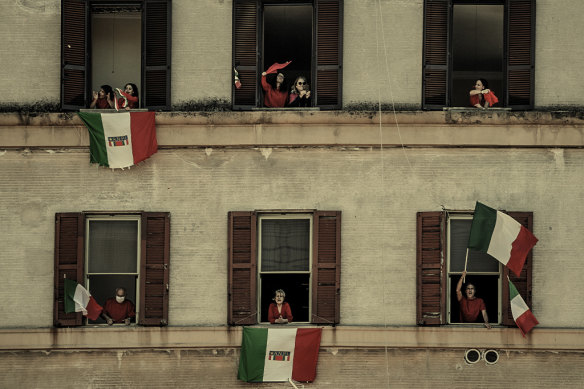
In the Rome suburb of Garbatella, residents in pandemic lockdown in 2020 come out to sing the anti-fascist song Bella Ciao on Liberation Day, marking the end of the Nazi occupation in WWII. Credit: Getty Images, digitally tinted
For Meloni, though, the radical left held little attraction. Politicised in her youth during the 15 years known as Italy’s Years of Lead – marked by bombings, assassinations and street violence, often incited by the infamous Marxist Red Brigades and several neo-fascist groups – she was drawn instead to the fringes of the far right.
At 15, she joined Fronte della Gioventu, the youth wing of the Italian Social Movement, a far-right party formed in 1946 by remnant disciples of the not-long-deceased fascist dictator Benito Mussolini. She had found her calling. Her rise through the ranks was vertiginous, from student activist to city councillor to parliamentarian to Italy’s Minister of Youth in 2008, at just 31. In 2012, she co-founded her own far-right party, the Brothers of Italy. A decade later, she became Italy’s first female prime minister – and the first to govern from the far right since Mussolini.
Today, Italy – with 58 million people and visited by more than 300,000 Australians in 2023 – is the Eurozone’s third-biggest economy and the world’s eighth-largest by GDP, according to the World Bank. Meloni is a major figure in European politics, president of a group of hard-right European parties, a “kingmaker” in the European Union, and recently host to the G7 group of nations conference in Puglia, in southern Italy.
She is scrutinised over her far-right background and conservative beliefs even while befriending politicians across the ideological spectrum, from Hungary’s leader Viktor Orban to US President Joe Biden and British PM Keir Starmer. What does her success tell us about the Byzantine nature of Italian politics? Has her agenda changed when faced with the realities of governing?
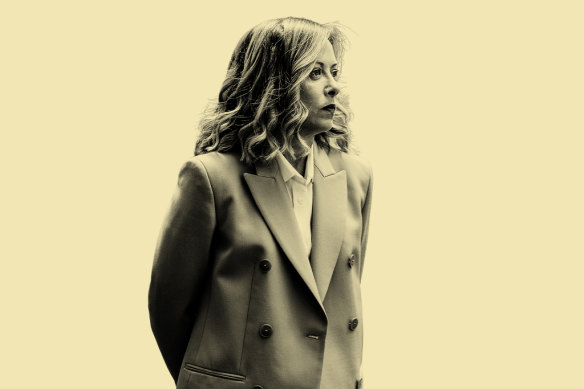
Giorgia Meloni in July: “I owe everything to my mother.”Credit: Getty Images, digitally altered
Where did Giorgia Meloni come from?
Life was not, initially, hardscrabble for Meloni, born in Rome in 1977. Her father, Francesco, was a tax adviser; his parents were a radio director and an actress. But in 1978, when Meloni was one, Francesco abandoned his family. Then a fire wrecked their apartment in the affluent suburb of Camilluccia, and her mother, Anna Paratore, took Meloni and her older sister, Arianna, to Garbatella to be nearer their grandparents. “I’ve never been one to feel sorry for myself, but there was very little money,” Paratore, now a romance novelist, told the Milanese newspaper Corriere della Sera in 2022.
In her autobiography, Io sono Giorgia (I Am Giorgia), Meloni describes a scene before her own birth where her mother, worried about money and her ailing marriage, considers having an abortion but turns away from the clinic at the last moment. “Without this brave and wise act, I would not have been born,” Meloni writes. “I owe my life to my mother and her courage; I owe everything to my mother.”
‘What being a waitress taught me, being a parliamentarian didn’t teach me.’
Giorgia Meloni
As a child, she was bullied for being overweight. “Why should it be legal to bully someone for being fat but illegal to bully someone for being gay?” she writes. In 2022, a neighbour told The Guardian: “I used to see Meloni and her sister coming home from school. She was tough.”
At 11, according to the BBC, Meloni discovered British writer J.R.R. Tolkien’s Lord of the Rings and would regularly dress up as a hobbit, childish fun that would develop into a reverence for fantasy literature: in 2023, she opened an exhibition about Tolkien at Rome’s National Gallery of Modern and Contemporary Art. “J.R.R. Tolkien became an object of neo-fascist fascination in the 1970s,” observes David Broder in his book Mussolini’s Grandchildren: Fascism in Contemporary Italy. “Meloni has termed Lord of the Rings an ‘extraordinary metaphor for man and his world’ and often identifies her cause with Tolkien’s Prince Faramir.”
Four years after joining Fronte della Gioventu, when she was 19, Meloni appeared on a news segment on French television at a political gathering, earnestly uttering a quote (in French) that has followed her to this day, describing Benito Mussolini as “a good politician”. At 29, she won a seat in the Italian Chamber of Deputies, one of the two Italian houses of parliament, and became its youngest-ever vice president.
Along the way, to help support her family, Meloni worked as a nanny, a waitress and a bartender at Rome’s Piper nightclub near the Villa Borghese. “What being a waitress taught me, being a parliamentarian didn’t teach me,” she said in 2013.
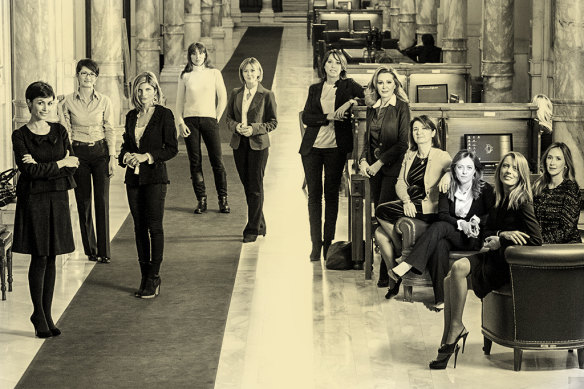
Female ministers and undersecretaries of Silvio Berlusconi’s government in 2011, with youth minister Giorgia Meloni third from the right. Credit: Getty Images, digitally tinted
Meloni’s beliefs are routinely labelled far right, including her hard lines on illegal immigration and climate change (such as pushing back on an upcoming EU ban on petrol and diesel cars) and opposing many of Italy’s tough COVID regulations during the pandemic. Yet, Brothers of Italy has also found a common cause with traditionalists. In its day, its precursor, Italian Social Movement (MSI), “attracted to their ranks a number of traditionalist Catholics, who found common ground with neo-fascists on a range of moral issues,” reports The Economist.
“I am Giorgia, I’m a woman, I’m a mother … I’m Christian,” she said in 2019. “She’s quite close to the Pope,” says Hervé Lemahieu, director of research at the Lowy Institute. “That’s an interesting relationship. She makes a lot of the fact that she’s a practising Catholic. Her life story doesn’t really back that up, in that sense, because she’s a single mum who’s never been married but, nevertheless, she makes a lot of traditional values and the Catholic Church.”
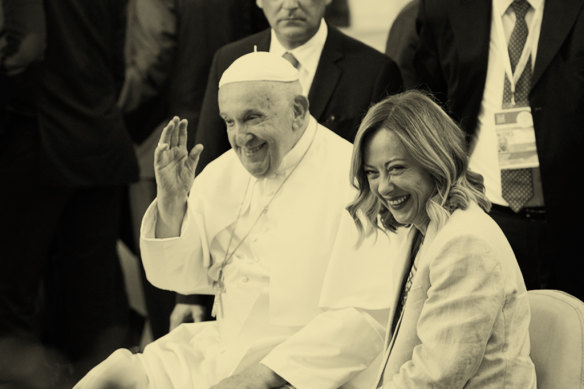
Pope Francis and Giorgia Meloni during the G7 summit in Puglia in June. Credit: Getty Images, digitally tinted
How did Meloni become prime minister?
It begins, in a way, back in October 1922, when Benito Mussolini, empowered by post-war disaffection, and his black-shirted National Fascist Party (Partito Nazionale Fascista) marched on Rome and seized power in what today we would call a bloodless coup. Mussolini first changed the law so the party that won the largest share of the vote, even if it were nowhere near a majority, would get two-thirds of the seats in parliament. The next moves were less subtle: in 1925, he declared all other political parties illegal and, in 1926, gave the fascists the power to make laws without the approval of parliament.
Italy, whose democratic roots stretched back to 509 BC (when Rome first became a republic) had ceded control to a dictator. Mussolini called his assorted followers – anarchists, discontented socialists, revolutionaries and discharged soldiers – the fasci di combattimento or “fighting bands”, named for the fasces, a tightly bound bundle of sticks into which an axe head was inserted in ancient Rome. Hence, fascism.
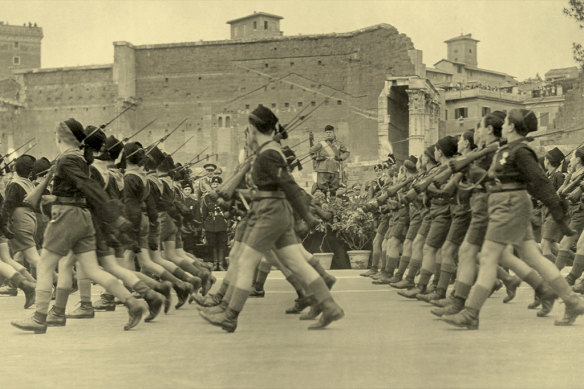
Benito Mussolini reviews fascist youth in Rome in 1934. Credit: Getty Images, digitally tinted
Il Duce (chief or boss), as he liked to be called, ruled brutally for 21 years, signing a “Pact of Steel” with German dictator Adolf Hitler in 1939, before being upended by Italy’s military failures in World War II. He was executed by partisans in April 1945 as he tried to escape to Switzerland in the closing months of an Allied victory. “Shot to death by a firing squad,” reported The New York Times. “[T]he man who once boasted that he was going to restore the glories of ancient Rome is now a corpse in a public square in Milan, with a howling mob cursing and kicking and spitting on his remains.”
Mussolini’s comeuppance was not, however, the end of fascism in Italy. Support for his nationalist ideology lingered, underpinning the rise of a new far-right political party, the Italian Social Movement (MSI) as early as 1946, the year Italy voted in a referendum to eliminate the monarchy, propelling King Umberto II into exile in Portugal, and to reinstitute a republic. MSI would eventually birth a new far-right party, the National Alliance, members of which then formed Meloni’s Brothers of Italy in 2012.
Nor did Il Duce’s death spell the end of Mussolinis in politics. His granddaughter Alessandra Mussolini, television personality, former actress and singer, has been a member of both houses of the Italian parliament as well as the European Parliament. Rachele Mussolini, another granddaughter and Alessandra’s half-sister, is a councillor in Rome for Brothers of Italy.
Yet in the aftermath of the war, it was no longer the defeated fascists who concerned the Allies but the ascendant communists, perceived as such a threat to democracy in the region and in Italy in particular, close to communist-threatened nations to its east, including Greece, to the extent that Britain and the US thought it necessary to intervene in elections in the 1940s and 1950s to keep them at bay.
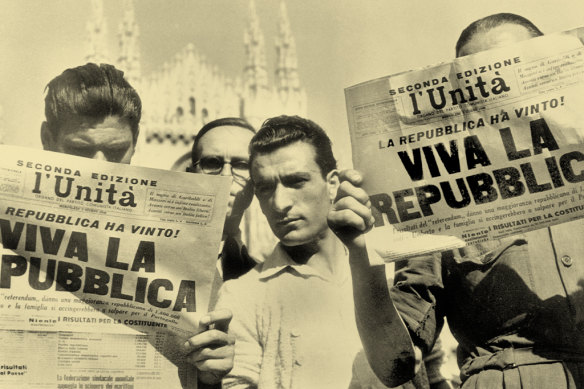
The proclamation of a new Italian republic is the top news in June 1946. Credit: Getty Images, digitally tinted
It is widely believed that the newly formed Central Intelligence Agency played an active role in both subverting the activities of communists and financing their rivals. A declassified CIA document from 1948 details the “consequences of communist accession to power in Italy by legal means”. “By processes made familiar in Eastern Europe, Italy would be eventually transformed into a totalitarian police state … From Italian bases, Soviet air and naval forces could effectively close the Sicilian Channel and endanger shipping throughout the Mediterranean. Fighter-escorted bombers could reach North African targets from Algiers to Derna (Libya) and could cover all of France except Brest and Cherbourg.”
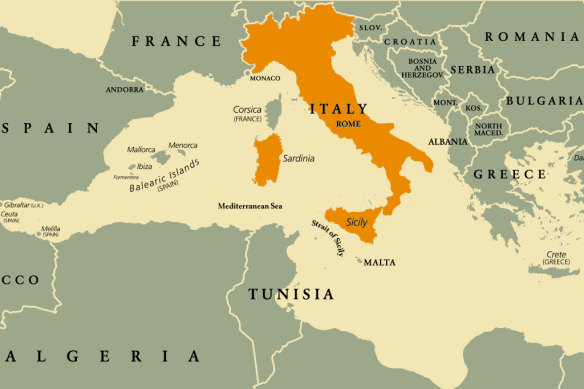
Credit: Getty Images, digitally altered
Thomas Boghardt, a senior historian at the US Army Centre of Military History, writes how recently discovered documents “show how seriously the Army took the threat of a communist Italy, and how far army intelligence officers were willing to go to counter it”. Today, Italy is still home to more than 12,000 US troops, the fourth-highest number for a host country.
‘There is certainly a degree of fluidity and the ever-present element of surprise in modern Italian politics.’
Simone Battiston, history and politics lecturer
To prevent Italy from again falling prey to a single party, its post-war electoral system, a form of proportional representation, was overtly designed to allow multiple minor parties to gain seats even with very small percentages of the overall vote.
The downside of proportional representation, it turned out, was a famously volatile parliamentary system riven by corruption, nepotism, division, short-term alliances, trading of favours and fragile backroom deals. Hence, Italy’s 68 governments since WWII, nearly one a year, compared to one every 2.6 years in Britain and 2.82 years in Spain, according to the Pew Research Centre. “There is certainly a degree of fluidity and the ever-present element of surprise in modern Italian politics, which tends to complicate the overall picture and confound outsiders,” says Simone Battiston, senior lecturer in history and politics at Swinburne University of Technology.
World events today only fuel this fragmentation, says Gabriele Abbondanza, an expert on Italian politics and foreign policy working in Australia, Italy and Spain. “Since 2000, Italy has received roughly 1.4 million irregular migrants by sea,” he says. “We have instability in North Africa and the Middle East, where thousands of Italian troops are stationed to support regional stability.” Other factors, such as Russia’s invasion of Ukraine and China “destabilising the status quo”, also contribute to fragmenting, he says, “because every citizen has their own opinion as to what should be done.”
(Meloni’s government last year imposed restrictions on non-government ships that rescue migrants in the Mediterranean; and, in a move to “offshoring”, two Italian-run camps in neighbouring Albania are set to house thousands of men rescued at sea while their asylum claims are processed. As for China, Italy will pull out of the Belt Road Initiative – Meloni has said Italy signing up, in 2019, was a “mistake” – but in Beijing in July, she signalled a “new phase” in relations, signing a co-operation deal in areas from shipbuilding to artificial intelligence, invoking Venetian merchant Marco Polo’s 13th-century travels on the Silk Road.)
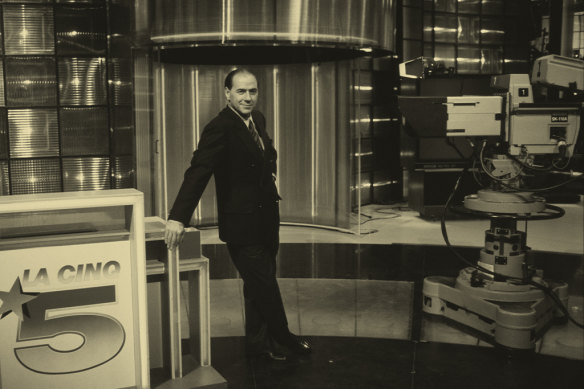
TV tycoon Silvio Berlusconi in a studio in Milan in 1986.Credit: Getty Images, digitally tinted
Holding together a government in this context necessarily requires the skills of a wheeler-dealer – such as those of Silvio Berlusconi, a billionaire media tycoon (and former owner of AC Milan football club) who founded the centre-right party Forza Italia (Come on, Italy) in 1993. Berlusconi went on to form governments enough times to be prime minister for a record post-war total of almost 10 years, surviving allegations of corruption, unproven sex offences and infamous “bunga bunga” parties. In 2008, in the usual round of horse-trading, Berlusconi tapped Meloni, then just 31, who had been elected to parliament on a far-right ticket two years earlier, to become minister for youth, the second-youngest government minister in Italian history.
‘The success of the party is certainly due to the political charisma and skills of Meloni … but also to the openings afforded by the Italian political system.’
They would later fall out, with Meloni later banding with far-right sympathisers to form Brothers of Italy, named after the opening line of the national anthem Fratelli d’Italia. “Ideologically,” says Simone Battiston, “Brothers of Italy is a national-conservative party. A key tenet of the party is the revival of national identity, which is intended to be the answer to the decline of Western civilisation. The success of the party is certainly due to the political charisma and skills of its leader, Meloni, and its well-disciplined party machine, but also to the openings afforded by the Italian political system.”
Italy is one of only a few countries to reserve seats in its parliament for Italian citizens living abroad. Francesco Giacobbe, one of more than 150,000 Italians living in Australia, is one of four overseas senators elected for the Asia-Africa-Oceanic region, and a member of the Democratic Party. “Giorgia Meloni was very good in opposition,” he says. “And she’s a very good speaker as well. And a very good politician, a very good strategist and tactician.” She is well-connected, too: her sister, Arianna, is the partner of Francesco Lollobrigida, the Italian minister of agriculture (who is, incidentally, a grandnephew of the late Italian actress Gina Lollobrigida).
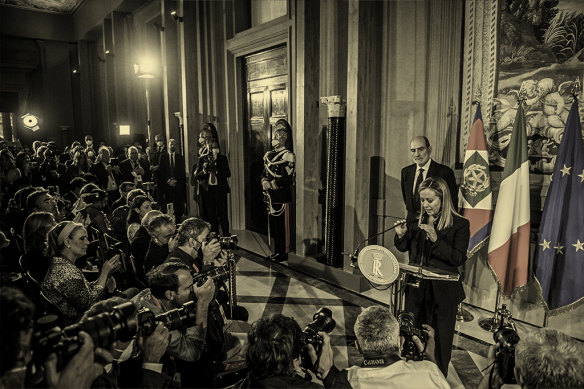
Giorgia Meloni speaks to the media after becoming prime minister in 2022.Credit: Getty Images, digitally tinted
In the 2022 election, Brothers of Italy snared around a third of the popular vote (winning 119 of 400 seats in the lower house) but – as is always the way in Italy – still required support from other parties, including Berlusconi’s Forza Italia to form a government. After Meloni reportedly denied some of Berlusconi’s requests for ministerial positions, a note emerged in Berlusconi’s handwriting saying Meloni was “overbearing, domineering, arrogant, offensive”. Nevertheless, they patched it up: Meloni became Italy’s first female prime minister on October 22, 2022.
“I don’t think that she seeks power for power itself, but she succeeds to do things that she’s always thought were necessary,” says Abbondanza. “She has a very peculiar personal history, family history, which might have impacted on her world view.”
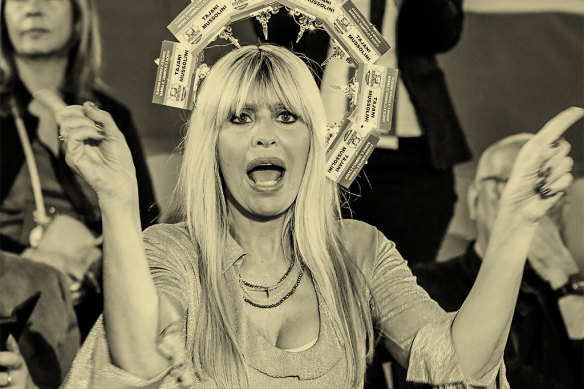
Alessandra Mussolini dances during an election concert at Forza Italia’s European election rally in Rome in May, 2024. Credit: Getty Images, digitally tinted
Could Italy really become a fascist dictatorship once more?
Like France’s Marine Le Pen, who has worked to “detoxify” her National Rally party from its fascist roots, so too has Meloni disavowed the more extreme elements of her party’s support base. When a video from a hidden camera emerged in June showing members of the youth section of her party overtly celebrating fascism, she emailed party members: “I am angry and saddened … there is no room in our ranks for those who play a caricature role that only serves the narrative our opponents want to create about us … we don’t have time to lose with those who want to make us go backward.”
Some observers believe Meloni has become a popular figure not because she embodies far-right nostalgia but because she has managed to shift her party away from the unelectable fringe and towards the centre right, where Berlusconi’s death last year left something of a power vacuum. “If Giorgia Meloni plays her cards well, she can fill in that political gap for years to come,” says Abbondanza.
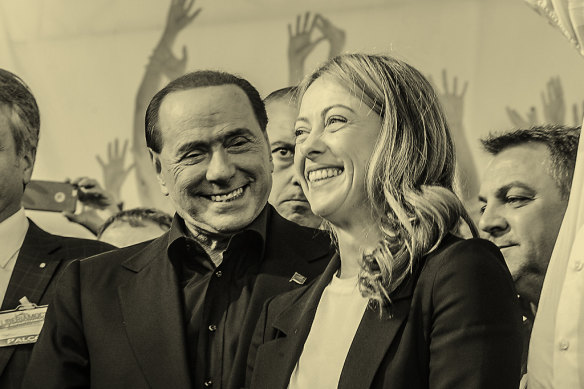
Silvio Berlusconi with Meloni at a rally in Bologna in 2015. Credit: Getty Images, digitally tinted
George Newth, lecturer in politics at the University of Bath, believes “there has been a mainstreaming and normalisation of the far right over the past three decades in Italy and, indeed, throughout Europe. Berlusconi played a key role in this: he took a revisionist view of Mussolini’s role in Italian history, believing him to be an essentially ‘benign dictator’. This provided a counter-narrative that contradicted the reality of the Italian republic’s anti-fascist foundations.”
As for the anxiety among left-leaning media when Meloni became prime minister, in practice, she and other hard-right leaders, such as Le Pen, have had to cushion their messages or abandon positions entirely to become electable. “The whole tenor and tone of the [2022] campaign was much more calm and moderate,” Alexander Stille, a professor at the Columbia Journalism School and the author of several books about Italian history and politics, reflected in 2022. “Now, that doesn’t mean that there aren’t people in her party who may, in the privacy of their home, defend Mussolini. But that’s clearly not what the electorate was demanding, nor was it what Meloni was offering.”
In elections for the European Parliament in June, Italian voters gave Meloni’s party the most votes among domestic contenders (28 per cent). She has more recently raised eyebrows after her party declined to vote for the re-election of the European Commission’s president, Ursula von der Leyen, who is from the centre-right but whose support also included the Greens – a move some analysts saw as Meloni keeping faith with grassroots support at home even as she tries to avoid tags of “hardline right” in Europe.
“Consider, first, all the things that have not happened,” notes The Economist of Italy. “Social policy has remained unaltered, despite the Brothers’ hostility to abortion and gay civil unions. It is true that there has been no progress towards gay marriage or same-sex adoption, but neither has there been any backsliding. Italy’s first female prime minister does not profess to be a feminist, but she is a tough single mother who unceremoniously dumped her partner for propositioning his female colleagues.” In 2023, Meloni abruptly broke up with her long-term partner, television presenter Andrea Giambruno, after he was recorded making lewd comments to female colleagues.
‘Italy is the only major Western European country to be led by a far-right leader. And the question is, is she less reactionary than we all thought?’
Hervé Lemahieu, Lowy Institute
While Meloni might have been expected to support “strongman” Russian leader Vladimir Putin, instead, she sides with Ukraine. Says Hervé Lemahieu: “It is, exactly, the realities of governing. That’s what makes her such an interesting case. Italy is the only major Western European country to be led by a far-right leader. And the question is, is she less reactionary than we all thought? Are the realities of governing conditioning her in a more centrist and predictable direction? Or are the extremes becoming more mainstream? So far, at least, she’s proven to be remarkably unremarkable in power.”
George Newth isn’t so convinced. “The idea was to bring far-right ideology into the mainstream by portraying extreme, racist policies as ‘normal’ ideas based on views shared by ordinary Italians.” The key issue, he says, is “not that Meloni has abandoned her extreme platform but rather that she has successfully framed her views as ‘not far-right but common sense’, ‘centre-right or conservative’ and even ‘non-ideological’. Many mainstream actors and outlets in both politics and the media have been willing to accept this narrative and aid in Meloni’s reconstruction.”
As with many far-right parties, Newth adds, rather than talking about race, Meloni’s party has referred to culture, identity and traditions, “all of which, however, are still racist dog-whistles which create an ‘us’ and ‘them’. This has involved, in many cases, conveying a dual message – one steeped in calculated ambivalence,” he says, “whereby they attempt to outwardly distance themselves from fascism while at the same time re-contextualising fascist ideas.”
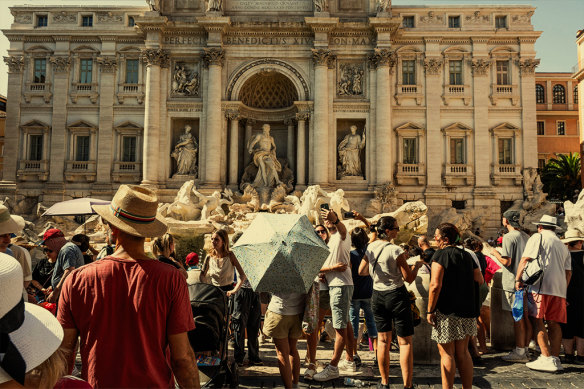
Tourists at the Trevi Fountain in Rome in July 2024.Credit: Getty Images, digitally tinted
So, is Italy still at risk of insidiously returning to its totalitarian, nationalist past? The short answer is, it’s unlikely – although some believe that Meloni’s current push to change the Constitution might be a step in that direction. Her proposal, before parliament, is to change how seats are allocated to guarantee the party with the most votes 55 per cent. She also wants prime ministers to be given guaranteed five-year terms.
It won’t be easy. Any change to the constitution must be approved by both houses of parliament twice, with a two-thirds majority necessary for the final round of votes. If that fails, a referendum has to be held. “The Constitution makes it very difficult to do very much in Italy. That’s what it was built for, to stop people from doing stuff, and it does the job,” says historian John Foot in The New Yorker.
A push in 2023 from some within her party to make it an offence to use English in official communications was treated less seriously. One news service pointed out that the commonly used term for hand sanitiser, the English word “dispenser”, would need to be replaced by the Italian expression: “dispensatore di liquido igienizzante per le mani”.
For now, says Hervé Lemahieu, “She’s got her eyes on the next election in 2027, and she’ll be keen not to be a one-hit wonder. She wants her Brothers of Italy party to move from the fringes of society to being firmly embedded in mainstream politics.”
“I’m not worried about fascists,” says Francesco Giacobbe. “I’m not worried about the possibility that there will be an authoritarian or dictatorship. The time is gone. So I think that the people, the community, the democracy is so mature that it’s almost impossible.”
Get fascinating insights and explanations on the world’s most perplexing topics. Sign up for our weekly Explainer newsletter.
Let us explain
If you'd like some expert background on an issue or a news event, drop us a line at explainers@smh.com.au or explainers@theage.com.au. Read more explainers here.